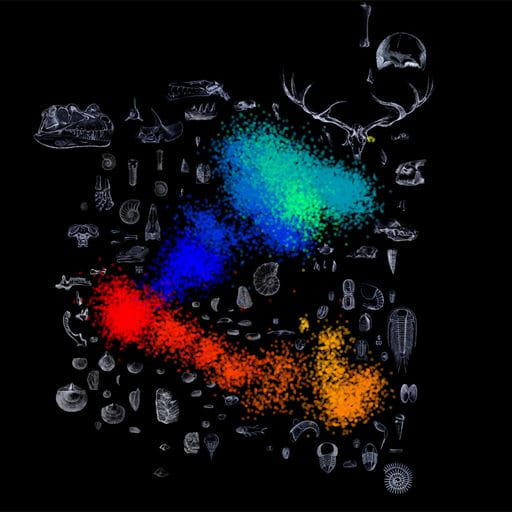Futuristic machine learning gives better insight into our pre-historic past
-
Date
Wed 9 Dec 20

Machine learning has been used for the first time to visualise the fossil record, highlighting how evolution and extinction have had long-term impacts across the past 600 million years.
The research, published in top journal Nature, applied powerful machine learning methods to visualise the entire fossil record of the past billion years in order to understand the relationships between major evolutionary events, like extinction and diversification.
Lead author Dr Jennifer Hoyal Cuthill, from the University of Essex’s School of Life Sciences and Institute for Analytics and Data Science, said: “Some of the most challenging aspects of understanding the history of life are the enormous timescales and numbers of species involved. By applying machine learning to visualise the known fossil record in its entirety, we can, so to speak, hold half a billion years of evolution in the palms of our hands, and gain new insights from what we see.”
The international study found that mass radiations that create many species and mass extinctions that kill them off have often occurred at separate times – which differs from the traditional expectation that major radiations should generally follow immediately after major extinctions had cleared the way.
Instead, the most significant evolutionary radiations were observed at times when life exploited new ecological opportunities, such as in the Cambrian explosion or the Carboniferous diversification of life on land.
Co-author Dr Nicholas Guttenberg, of GoodAI, said: “The ecosystem is dynamic, you don’t necessarily have to chip an existing piece off to allow something new to appear.”
An exception to this rule was the extremely severe end-Permian mass extinction, which was followed by two major radiations.
Using archived age distributions of over 100,000 fossil species, the machine learning method represented each of these species in a virtual space that best represented their relative ages. This provided a human-readable visualisation of the overlaps of fossil species in time, which helped the researchers to see the impacts of major events in evolutionary history.
The research, which involved a team of scientists from institutions including the Tokyo Institute of Technology, GoodAI, Cross Compass and Uppsala University, looked at both occurrences of fossil species over time and co-existence of different species at the same time.
Occurrences show the length of time species tend to exist for and how normal species lifespans are disrupted by major evolutionary events like mass extinctions. Co-occurrences also explain whether these species were likely to meet each other.
For example, the probability of co-occurrence between species like ours living today and species from the Cretaceous, like Tyrannosaurus rex is close to zero. “T. rex was born too soon for us to have any chance to meet it,” added, said Dr Hoyal Cuthill.
The study then showed that the top 30 species extinction or radiation events in evolutionary history markedly disrupted the structure of the fossil record.
The researchers then developed a new measure called the decay clock which looks back in time to see how many of species present at a particular time were also there at each preceding time.
The decay-clock counts that were measured for each point in evolutionary history showed that major extinction events, such as the big five mass extinctions, rapidly erased prior connections to the past by simultaneously removing large proportions of existing species.
More surprisingly, the study also showed that evolutionary radiations, in which many species simultaneously appeared, could also lead to rapid evolutionary decay meaning that there was a large change to the prior ecosystem.
As for the present day, Dr Hoyal Cuthill added: “For each extinction that happens on our watch permanently erases a species, which may have existed for millions of years up to now.”
The modern extinction crisis is eroding biodiversity that was already disrupted compared to the long-term average. This means that the timescale over which most Quaternary species have persisted is already lower than the long-term equilibrium.
Image above: colours represent the geological periods from the Tonian (yellow), to the current Quaternary Period (green). Image credit: J. Hoyal Cuthill and N. Guttenberg.
.jpg?mh=500&mw=500&hash=6568B6C9CCF5290A596BEF6678B6AD0E)



